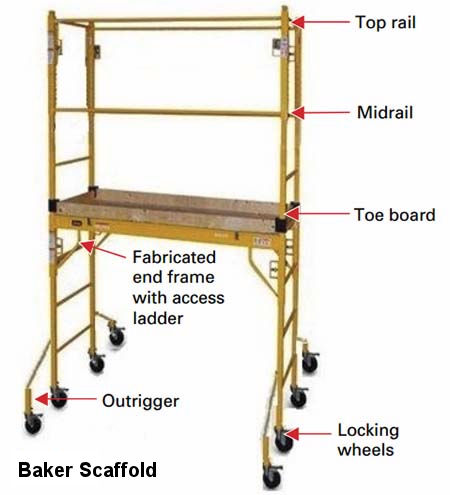22.C Metal Scaffolds and Towers.
22.C.01 Scaffold components made of dissimilar metals must not be used together unless a CP has determined that galvanic action will not reduce the strength of any component to a level below that required by Section 22.B.09.
22.C.02 The sections of metal scaffolds must be securely connected and all braces must be securely fastened.
22.C.03 A ladder or stairway must be provided for access and must be affixed or built into all metal scaffolds and so located that, when in use, it will not have a tendency to tip the scaffold.
22.C.04 Tube and coupler scaffolds.
- Tube and coupler scaffolds must have posts, runners, and bracing of nominal 2 in (5 cm) (outside diameter) steel tubing or pipe: other structural metals, when used, must be designed to carry an equivalent load. The size of bearers (outside diameter) and the spacing of posts must meet the requirements contained in ANSI A10.8.
- Tube and coupler scaffolds must be limited in heights and working levels to those permitted in ANSI A10.8. Drawings and specifications for tube and coupler scaffolds that exceed the limitations in ANSI A10.8 must be designed by a RPE.
- All tube and coupler scaffolds must be constructed to support four times the maximum intended loads, as set forth by ANSI A10.8 or as specified by a RPE (with knowledge in structural design).
- Runners must be erected along the length of the scaffold and must be located on both the inside and the outside posts at even heights.
- (1) When tube and coupler guardrails and midrails are used on outside posts, they may be used in lieu of outside runners. If guardrail systems are removed to other levels, extra runners must be installed to compensate.
- (2) Runners must be interlocked to form continuous lengths and coupled to each post.
- (3) The bottom runners must be located as close to the base as possible.
- (4) Runners must be placed not more than 6 ft - 6 in (1.9 m) on center.
- Bearers.
- (1) Bearers must be installed transversely between posts.
- (2) When coupled to the post, the inboard coupler must bear directly on the runner coupler. When coupled to the runners, the couplers must be kept as close to the post as possible.
- (3) Bearers must extend beyond the posts and runners and must provide full contact with the coupler.
- Bracing across the width of the scaffold must be installed at the ends of the scaffold at least every fourth level vertically and repeated every third set of posts horizontally.
- (1) Such bracing must extend diagonally from the outer post or runner at this level upward to the inner post or runner at the next level.
- (2) Building ties must be installed adjacent to bracing.
- Longitudinal diagonal bracing across the inner and outer rows of poles must be installed at approximately a 45º angle in both directions from the base of the end post upward to the extreme top of the scaffold.
- (1) Where the longitudinal length of the scaffold permits, such bracing must be repeated beginning at every fifth post.
- (2) On scaffolds where the length is shorter than the height the longitudinal bracing must extend diagonally from the base of the end posts upward to the opposite end posts and then in alternating directions until reaching the top of the scaffold.
- (3) Where conditions preclude the attachment of bracing to the posts, it may be attached to the runners.
22.C.05 Metal frame scaffolds.
- Spacing of tubular welded panels or frames must be consistent with the loads imposed.
- Scaffolds must be properly braced by cross, horizontal, or diagonal braces (or combination of these) to secure vertical members together laterally, and the cross braces must be of such length as will automatically square and align vertical members so that the erected scaffold is always plumb, square, and rigid. All brace connections must be made secure.
- Scaffold legs must be set on adjustable bases or plain bases placed on mudsills or other foundations adequate to support the maximum rated loads.
- Frames must be placed one on top the other with coupling or stacking pins to provide vertical alignment of the legs.
- Where uplift may occur, panels must be locked together vertically by pins or other equivalent suitable means.
- Drawings and specifications for all frame scaffolds over 125 ft (38.1 m) in height above the base plates must be designed by a RPE.
22.C.06 Manually propelled mobile scaffolds, including mobile work stands, such as "baker scaffolds".
- All wheels and casters on rolling scaffolds must have a positive locking device, securely fastened to the scaffold, to prevent accidental movement.
- All casters or wheels must be locked when a scaffold is occupied.
- The force necessary to move the mobile scaffold must be applied as close to the base as practical and provision must be made to stabilize the tower during movement from one location to another.
- Rolling scaffolds must be used only on firm, level, and clean surfaces.
- Free-standing mobile scaffold working platform heights must not exceed three times the smallest base dimension.
- No person must be allowed to ride on manually propelled scaffolds unless all of the following conditions exist:
- (1) The ground surface is within 3º of level and free from pits, holes, or obstructions;
- (2) The minimum dimension of the scaffold base (when ready for rolling) is at least one- half of the height and outriggers, if used, are installed on both sides of staging;
- (3) The wheels are equipped with rubber or similar resilient tires; and
- (4) All tools and materials are secured or removed from the platform before the scaffold is moved.
Knowledge Check Choose the best answer for the question.
22-6. How much weight must tube and coupler scaffolds be able to support?
You forgot to answer the question!


